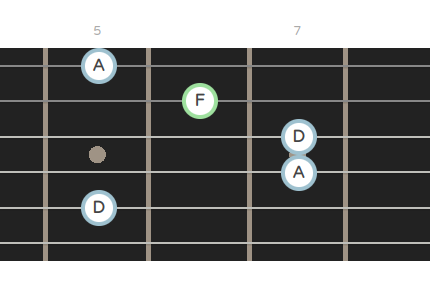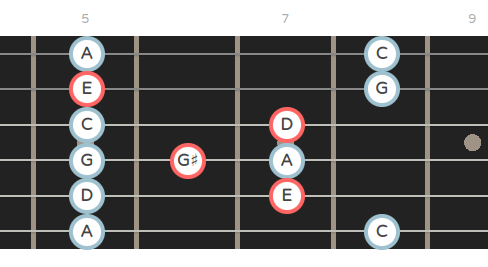on
Break up with boring box shapes - and write more interesting solos
When it comes to soloing, improvising and even writing, a lot of guitar players find themselves sticking to the same notes and scale shapes and getting bored. Here are three quick ways you can break out of a rut and make your solos more interesting and compelling with almost no additional effort.
Add notes from the chord
Pentatonic and other box shapes can be a great starting point for a solo or melody line. They’re reliably usable over almost any chord in a typical blues progression, provided you’re in key. But that same versatility can make them overused and, frankly, predictable and boring. One of the quickest ways you can add flavour to a melody or solo is to use notes from the underlying chord.
Here are the notes of a simple Dm barre chord, the IV chord in a typical Am blues progression:
Highlighted in green is the note F - the flattened, or “minor”, third that gives the chord its minor tonality. The notes around it all form part of the A minor pentatonic, so it’s easy to see why that’s a fitting scale to play over the top. But adding the F note can easily add flavor to the scale when soloing over the IV chord. It’s easy to remember when to mix in this note in the midst of an improvisation because it’s right there in the chord progression underneath.
Imply a chord that isn’t there
This technique is especially effective when playing over a progression of simple chords, for example a power chord progression in a rock context. Because the chords consist only of the root and fifth notes you can mix in notes from almost any chord that builds on those. This can drastically change the feel of the music by ‘implying’ the note exists in the underlying chord; moving the tonality from major to minor or even modal.
The possibilities are endless but to demonstrate, let’s stay in the Am pentatonic. Superimposed below are the notes from the A6 chord over the same scale:
You can play with the addition of the F#. It’s excellent as a passing note or bent up to the G. But the effect is the same, to imply major tonality and add an interesting flavour to the scale. Similarly, the major third, C# in this key, is a common addition to the minor pentatonic scale and you can play with adding it to see how it affects the tonality.
Knowing a few interesting chords in this position can really help. With the same Am pentatonic shape when encountering the V chord, E, you can change the feel again by borrowing from the E7 chord:
The G# provides a nice note to transition over that emphasizes the progression underneath while adding some color.
Use dissonance and chromaticism
Finally, dissonance. When used sparingly and the right way it really can be your friend. Most of the time, guitar players will avoid playing notes that clash in a way that sounds unpleasant. Intentionally, at least!
Common dissonant intervals include the semitone and the “tritone” (diminished fifth). These sound particularly harsh. Yet they’re found very commonly in modern music. Not least in the “blue note” that gives blues its signature sound and feel.
The purpose of dissonance is to build tension. So using dissonance is particularly effective before a strong resolution as it creates the impression that the melody wants to resolve.
A deep dive into the use of dissonance is outside the scope of this article. But it’s simply worth remembering as you try to make a solo or melody “fit” that sticking to known, consonant and familiar notes is not always the best way to make a piece move!


